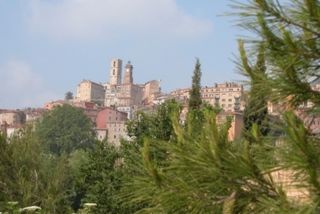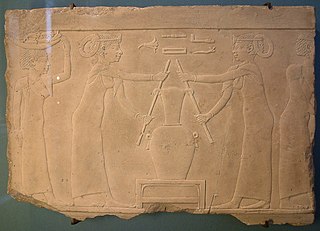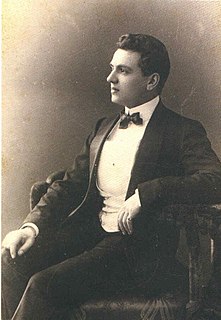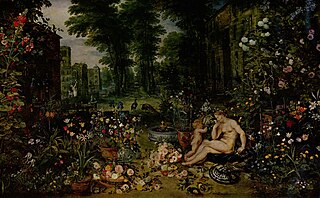
Grasse is a commune in the Alpes-Maritimes department, on the French Riviera.
Eau de Cologne, or simply cologne, is a perfume originating from Cologne, Germany. Originally mixed by Johann Maria Farina in 1709, it has since come to be a generic term for scented formulations in typical concentration of 2–5% and also more depending upon its type essential oils or a blend of extracts, alcohol, and water. In a base of dilute ethanol (70–90%), eau de cologne contains a mixture of citrus oils including oils of lemon, orange, tangerine, clementine, bergamot, lime, grapefruit, blood orange, and bitter orange. It can also contain oils of neroli, lavender, rosemary, thyme, oregano, petitgrain, jasmine, olive, oleaster, and tobacco.

Musk is a class of aromatic substances commonly used as base notes in perfumery. They include glandular secretions from animals such as the musk deer, numerous plants emitting similar fragrances, and artificial substances with similar odors. Musk was a name originally given to a substance with a strong odor obtained from a gland of the musk deer. The substance has been used as a popular perfume fixative since ancient times and is one of the most expensive animal products in the world. The name originates from the Late Greek μόσχος 'moskhos', from Persian 'mushk', ultimately from Sanskrit मुष्क muṣka meaning "a testicle", from a diminutive of मूष् mūṣ ("mouse"). The deer gland was thought to resemble a scrotum. It is applied to various plants and animals of similar smell and has come to encompass a wide variety of aromatic substances with similar odors, despite their often differing chemical structures and molecular shapes.

Evernia prunastri, also known as oakmoss, is a species of lichen. It can be found in many mountainous temperate forests throughout the Northern Hemisphere, including parts of France, Portugal, Spain, North America, and much of Central Europe. Oakmoss grows primarily on the trunk and branches of oak trees, but is also commonly found on the bark of other deciduous trees and conifers such as fir and pine. The thalli of oakmoss are short and bushy, and grow together on bark to form large clumps. Oakmoss thallus is flat and strap-like. They are also highly branched, resembling the form of deer antlers. The colour of oakmoss ranges from green to a greenish-white when dry, and dark olive-green to yellow-green when wet. The texture of the thalli are rough when dry and rubbery when wet. It is used extensively in modern perfumery.

Farnesol is a natural 15-carbon organic compound which is an acyclic sesquiterpene alcohol. Under standard conditions, it is a colorless liquid. It is hydrophobic, and thus insoluble in water, but miscible with oils.

Fragrance extraction refers to the separation process of aromatic compounds from raw materials, using methods such as distillation, solvent extraction, expression, sieving, or enfleurage. The results of the extracts are either essential oils, absolutes, concretes, or butters, depending on the amount of waxes in the extracted product.

Notes in perfumery are descriptors of scents that can be sensed upon the application of a perfume. Notes are separated into three classes; top/head notes, middle/heart notes, and base notes; which denote groups of scents which can be sensed with respect to the time after the application of a perfume. These notes are created carefully with knowledge of the evaporation process and intended use of the perfume. The presence of one note may alter the perception of another—for instance, the presence of certain base or heart notes will alter the scent perceived when the top notes are strongest, and likewise the scent of base notes in the dry-down will often be altered depending on the smells of the heart notes.

The word perfume is used today to describe scented mixtures and is derived from the Latin word, "per fumus," meaning through smoke. The word Perfumery refers to the art of making perfumes. Perfume was further refined by the Romans, the Persians and the Arabs. Although perfume and perfumery also existed in East Asia, much of its fragrances were incense based. The basic ingredients and methods of making perfumes are described by Pliny the Elder in his Naturalis Historia.

Cosmetics ingredients come from a variety of sources but, unlike the ingredients of food, are often not considered by most consumers. Cosmetics often use vibrant colors that are derived from a wide variety of sources, ranging from crushed insects to rust.

Methyl anthranilate, also known as MA, methyl 2-aminobenzoate, or carbomethoxyaniline, is an ester of anthranilic acid. Its chemical formula is C8H9NO2. It has a fruity grape smell, and one of its key uses is as a flavoring agent.
Cosmetics & Toiletries (C&T) is a magazine focusing on research and development in the cosmetics and personal care industry. The magazine is published by Allured Business Media. It is delivered to 97 countries on a monthly basis, and is geared toward formulators, scientists, researchers, chemists and R&D management in the industry. The magazine is available in both print and online magazine format. The headquarters is in Northbrook, Illinois.

Benzyl salicylate is a salicylic acid benzyl ester, a chemical compound most frequently used in cosmetics as a fragrance additive or UV light absorber. It appears as an almost colorless liquid with a mild odor described as "very faint, sweet-floral, slightly balsamic" by those who can smell it, but many people either can't smell it at all or describe its smell as "musky". Trace impurities may have a significant influence on the odour. It occurs naturally in a variety of plants and plant extracts and is widely used in blends of fragrance materials.

Ernest Beaux was a Russian-born French perfumer who is best known for creating Chanel No. 5, which is perhaps the world's most famous perfume.
Henri Robert is a French perfumer and chemist, he is best known for his role as Chief Perfumer at Les Parfums Chanel from 1953–1978.

Uninhibited is a women's fragrance from Parfums Stern, and is the first fragrance to be endorsed by singer-actress Cher. The fragrance was released in November 1987, nine days before the release of her nineteenth album Cher.
Synthetic musks, known as white musks in the perfume industry, are a class of synthetic aroma compounds to emulate the scent of deer musk and other animal musks. Synthetic musks have a clean, smooth and sweet scent lacking the fecal notes of animal musks. They are used as flavorings and fixatives in cosmetics, detergents, perfumes and foods, supplying the base note of many perfume formulas. Most musk fragrance used in perfumery today is synthetic.

Philip Kraft is a German fragrance chemist. Since 1996 he has been employed by Givaudan, a leading Flavor and Fragrance company, where he designs captive odorants for use in perfumes. He has lectured at the University of Bern, the University of Zurich, and the ETH Zurich.
Robertet Group is a French fragrance and flavor manufacturer that specializes in natural raw materials founded in 1850.

Stephen V. Dowthwaite is an English perfumer, perfumery educator, programmer and writer. He is the founder of PerfumersWorld, a resource for professional perfumers. He is known for developing The ABC's of Perfumery, a comprehensive system of odour classification and perfume creation, and a training course in The Art and Technology of Perfumery.


















